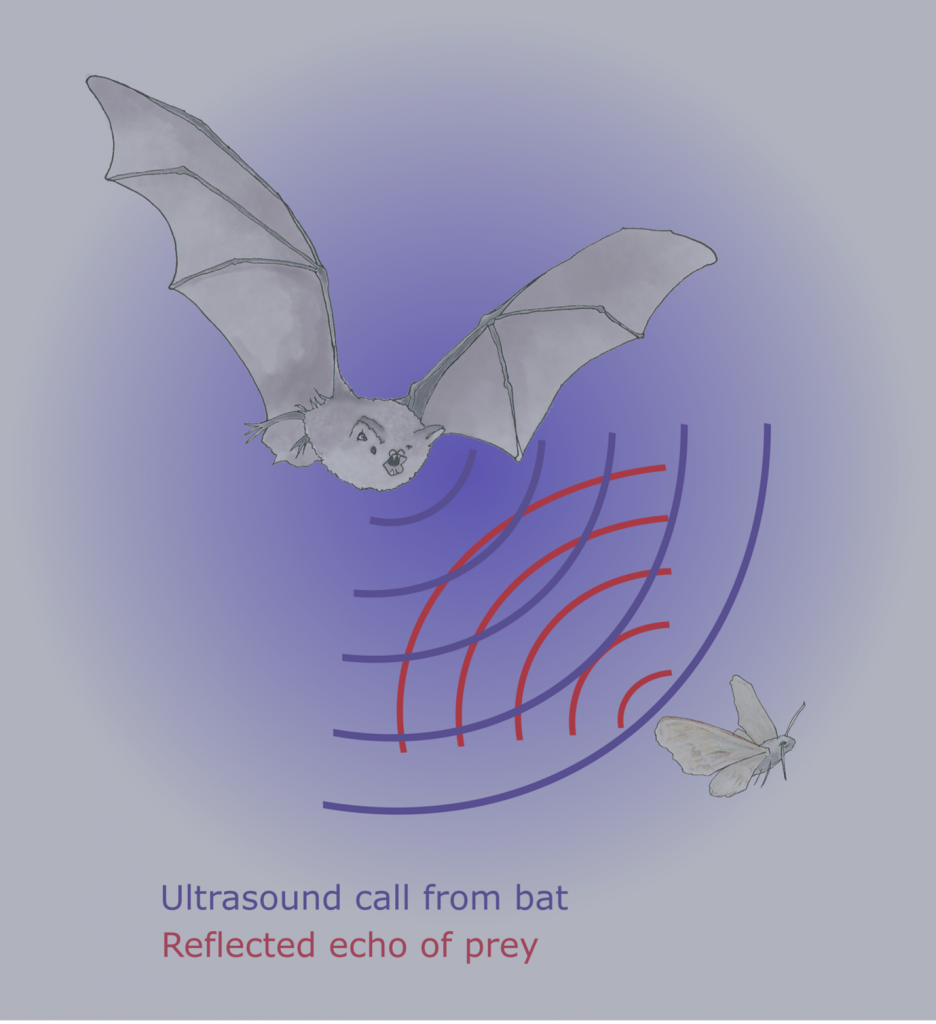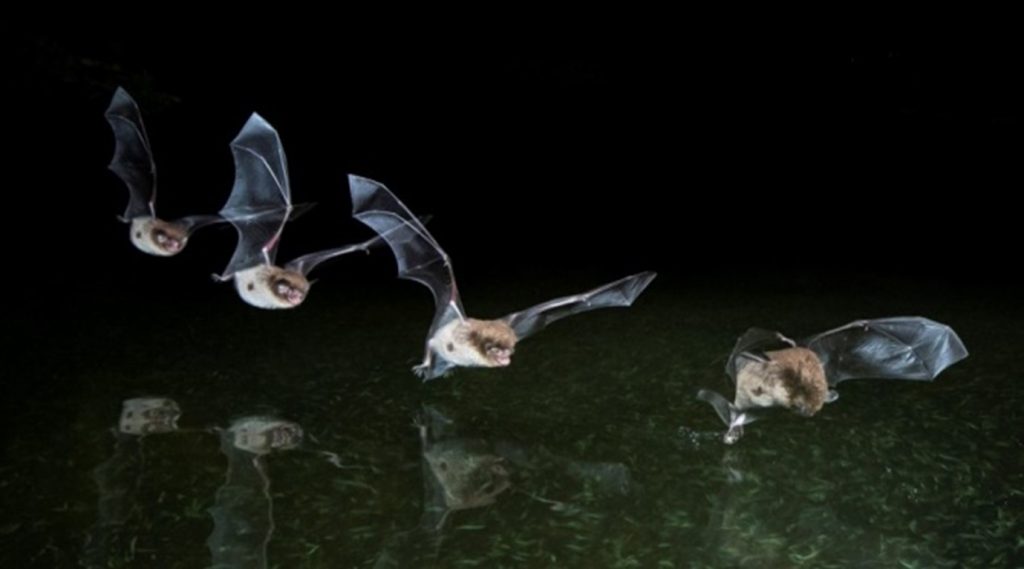There are at least thirteen different kinds of bat living in and around the Town Park and Smallbrook Meadows. These include rare Greater horseshoe and Lesser horseshoe bats, Bechstein’s bats and Barbastelle bats.
Bats come out at night to feed on insects. You can see them around sunset up against the sky or over the park lake.
They hunt for a range of food including large dung beetles, moths, midges and mosquitoes, using echolocation to find their prey. Echolocation is like the sonar used by submarines and dolphins. Bats ‘shout’ sound waves which bounce off objects and return to them as echoes. Rapidly repeated echoes give bats information on their surroundings, helping them to find their way in the dark and to chase and target their food.

Some large-eared bats can hear moths. They only need to echolocate very quietly and the moths find it difficult to hear them.
Other bats rely on their sensitive hearing to listen to prey without using echolocation at all.
Bat calls are ultrasonic, mostly too high for human hearing. We can listen in on hunting bats by using a handheld ‘bat detector’ which converts their calls to a frequency we can hear.
Bats make characteristic calls which allow us to identify different species. Heterodyne bat detectors are small, relatively cheap and easy to use. By tuning them to the strongest part of a bat call we can estimate their ‘peak frequency’ to tell which species is flying past.
Bats at Warminster Park Lake
Common pipistrelle and Soprano pipistrelle bats feed in great numbers around water, eating midges and other small flies. You can listen to Soprano pipistrelles at around 55 kHz on a bat detector and Common pipistrelles at around 45 kHz. Click here to hear a Soprano pipistrelle.
Amongst the pipistrelles will be smaller numbers of Daubenton’s bat, flying low over the water, skimming insects from the water’s surface with their feet; they may sound a bit like machine gun fire if you tune a detector to around 40kHz .

Foraging high over the lake, the larger Noctule bat and Serotine bat can be heard, too; their echolocation sounds like loud clapping. Noctules produce a slow clap at 18-20kHz. Serotines produce a more rapid series of claps at 28-32 kHz.
Other species of bat can be encountered at the park lake. If you’re really lucky, you may even hear the warbling of a Lesser horseshoe bat at around 108kHz.
More information on using bat detectors to identify bats can be found here: www.bats.org.uk/about-bats/bat-detectors-1
Bats of the World
There are over 1400 species of bat across the world. They make up 20% of all mammal species and are the only mammal that can fly.
Bats are found on all continents except Antarctica and occupy a great variety of habitats. Eighteen bat species breed in the UK. Seventeen of these have been recorded in Wiltshire. From time to time vagrant bat species fly across from continental Europe, too.
Bats play a very important role maintaining healthy, balanced ecosystems by
- dispersing seeds in tropical rainforests
- pollinating hundreds of plants worldwide including important tropical fruits such as wild banana and Agave plants (used to make Tequila!)
- fertilising soil. In many parts of the world bat guano is harvested for fertiliser on small-holdings.
- consuming insects, many of which may be agricultural pests or spread diseases such as malaria. Around the world different species of bat also eat fish, scorpions, frogs, birds, small mammals, pollen, nectar, fruit or blood.
Don’t Blame the Bats
There are fears and myths about bats and disease which are threatening their conservation because of the Covid-19 pandemic.
COVID-19 is a human disease. People are responsible for its transmission to other humans around the world, not bats or other wildlife.
https://www.bats.org.uk/news/2020/08/dont-blame-bats-campaign-launch
If you’d like to know more about our local bats please visit the Wiltshire Bat Group and Wiltshire Mammal Group here:
https://wiltshiremammals.wordpress.com/
Further information on bats and how to help them can be found on the Bat Conservation Trust website at https://www.bats.org.uk/
Thank you to the BCT sound recordists Philip Briggs (Soprano pipistrelle) Jules Agate (Daubenton’s bat, Noctule bat and Serotine bat) and Jon Russ (Lesser Horseshoe bat). This factsheet was produced by the Sustainable Warminster community group in partnership with Gareth Harris Ecology and Conservation and the Wiltshire Bat Group who undertook bat surveys in and around Smallbrook Meadows Nature Reserve in 2018 and 2019, by kind permission of the Wiltshire Wildlife Trust and local landowners, with funding from Sustainable Warminster and Wiltshire Wildlife Community Energy Fund.
This factsheet is part of the Smallbrook Meadows Bat Project funded by the Tesco Bags of Help community grant scheme where the money raised by the carrier bag charge in Tesco stores is used to fund community projects. The Town Council has kindly co-funded the bat interpretation board in the Lake Pleasure Grounds.








